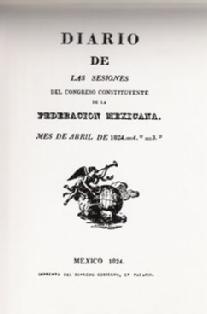Looking towards Philadelphia from Anahuac
Looking towards Philadelphia from Anahuac: the constitution of the United States of America in the 1823-24 Mexican Constituent Congress.

Throughout the nineteenth century, many scholars of Mexico’s first constitution have assured that it had essentially been inspired in the Constitution of the United States and that its failure was a result of the bad quality of the copy made by Mexican deputies to the Constituent Congress. As time went by, this position became harder to sustain as more and more authors pointed out that the Spanish Constitution of 1812 had had at least as much influence in the Mexican text as the North American one. Some twentieth century historians then argued that the 1824 Constitution was actually an amalgam of both charters which had taken the federal system of government and the principles of ‘checks and balances’ from the American model, and the principles of ‘sovereignty bested on the nation’, popular representation and the natural and political rights of men from the Spanish one.
More recently other authors have gone even farther arguing, form a more radical position, that not even the federal system of the 1824 Constitution could be considered the direct result of United States influence. For these authors, the whole idea of the 1824 Constitution being a copy of the American model had simply derived false accusation raised by the centralists as they struggled to move the country away from federalism. According to them, ‘the first Mexican federalism is better understood as Jeffersonian anti-federalism, meaning, the kind of system which would stress state autonomy; it was therefore more radical and paradoxically a lot less center oriented than the American one’. Thus, the origins of this peculiar style of, ‘almost confederate’, federalism were to be found not in Philadelphia but in ‘the insurgent struggle which had shown the towns their strength and [in] the 1812 Constitution [which] had granted them representation in constitutional town councils’.
These controversies brought about several studies regarding the foreign influences which could be identified in the 1824 Constitution. Some of these works have found that various constituent deputies had regular access to foreign constitutional texts and political writings, even if their copies were not always of the best quality. Unfortunately, these studies concerning the sources which were physically available to members of early nineteenth century Mexican political elites are, again, not exempt of disagreements.
For example, regarding United States influence in Mexican constitutionalism, the circulation, or lack there-of, of the classical analysis of the American Constitution, the Federalist Papers, has been strongly debated. While some authors assure that, in the nineteenth century, Latin American knowledge of it was very limited, others sustain that translations of loose articles were already circulating in Mexico around 1822. Finaly, some other authors highlight the fact that besides the problem represented by limited circulation, other issues, like differences between translations and editing techniques of the time, caused some of the original ideas and meanings to suffer deformation or depletion.
Never the less, all these works have a common shortcoming. In one way or another, almost all the authors who have studied the issue, particularly law scholars, have made the mistake of trying to analyze the influence North American constitutionalism had on the Mexican State’s founders from a modern, contemporary, point of view. Even those studies about the sources through which our first constituents obtained their more or less imperfect knowledge of the Philadelphia Constitution seem to have forgotten the fact that its influence was widely discussed by contemporaries of the 1824 Constitution. And not only by members of the centralist group, but also by the federalists and the Constituent Congress at large, as it can be seen in the preamble to the constitution published on October 4th, 1824, where it was clearly stated that:
The division of states, the installation of their respective legislatures and the erection of a multitude of bodies which have been born in the short period of eleven months, will testify whether Congress has largely fulfilled the towns’ expectations or not, without by that trying to take all the glory of so prosperous principles, and even less that of the original invention of the institutions it has dictated. Happily it had a people docile to the voice of duty, and a model to imitate in the flourishing Republic of our neighbors to the North.
The question, therefore, should not be whether the 1824 Constitution was influenced by the Philadelphia Constitution or not. Once we have recognized that the very founders of the Mexican State felt a strong North American influence over the constitutional model they were about to adopt, we are forced to ask ourselves how did these men understand the United States constitutional model. What constitution did they believe they were copying? Only when we have answered these questions will we be able to understand what kind of an influence from the 1787 Constitution of the United States of America did they really experience and maybe then we will acquire a better understanding of the Mexican Federal Constitution of 1824.
Some unforgivable oversight, or some other hidden reason, has caused some of the sources which should have been of obligated consultation for the study of this issue to be practically ignored. As far as I know, nobody has conducted a detailed analysis of the Constituent Congress’ debate records, or of the Draft Constitution for that matter, looking for references to the Philadelphia Constitution. In this paper I offer precisely that: an account of the various appearances of the United States model throughout the discussions of the first constituent moment of independent Mexico.


